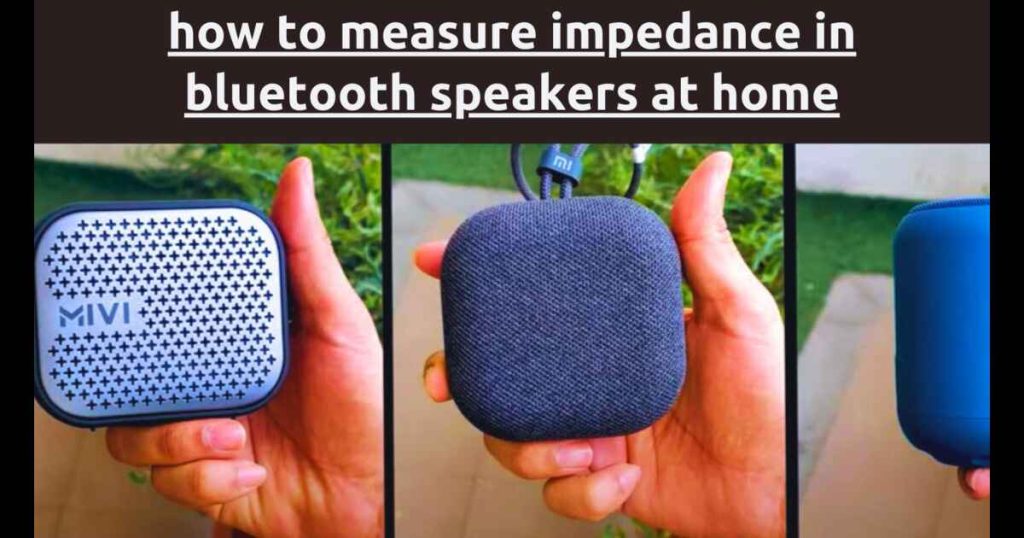
Measuring the impedance of Bluetooth speakers is a valuable skill for audio enthusiasts seeking a deeper understanding of their equipment’s technical specifications. While it may seem daunting, measuring speaker impedance at home is feasible with the right tools and guidance. In this article, we present a step-by-step guide on how to measure impedance in Bluetooth speakers within the comfort of your home.
Also read our comprehensive guide on impedance of Bluetooth speaker and Is Lower Impedance Always Superior in Bluetooth Speakers.
How to Measure Impedance in Bluetooth Speakers at Home?
Ever wondered how we can unlock the secrets of our Bluetooth speakers’ power at home? Well, let’s embark on an exciting journey to uncover the magic behind measuring something super cool called “impedance” right in our own space! We’ll dive into the world of sound technology and discover how to find this hidden power within our speakers, all from the comfort of home sweet home!
Measuring impedance in Bluetooth speakers might sound super technical, but it’s like a secret code that helps us understand how powerful our speakers can be. With just a few tools and a sprinkle of curiosity, we’ll learn how to uncover this hidden treasure in our speakers. So, are you ready to explore the awesome world of impedance right in your own space? Let’s dive in and discover how to measure the power of our Bluetooth speakers, right at home!
Understanding Speaker Impedance
Delving into the heart of sound technology, let’s unravel the intricate workings of ‘Speaker Impedance,’ exploring its nuances and impact on our audio world.
Importance of Impedance Measurement
Speaker impedance, measured in ohms, indicates the resistance a speaker offers to the electrical current from the amplifier. It’s a crucial specification that influences sound quality and compatibility.
Preparation and Tools Required
Before starting, gather essential tools: a digital multimeter (with impedance measurement capabilities), speaker wires, and if needed, a small screwdriver for accessing speaker terminals.
Step-by-Step Guide to Measure Impedance
Step 1: Power Off and Disconnect
Ensure the Bluetooth speaker is powered off and disconnected from any audio sources. Safety first!
Step 2: Access Speaker Terminals
If necessary, remove the cover or access panels to reach the speaker terminals without causing any damage.
Step 3: Set Up the Multimeter
Switch the digital multimeter to the impedance (ohms) setting. Ensure the meter’s range encompasses the expected impedance of the speaker (commonly 4-8 ohms).
Step 4: Connect Multimeter Probes
Connect the multimeter probes to the speaker terminals. Red probe to the positive (+) terminal and black probe to the negative (-) terminal.
Step 5: Measure Impedance
With the multimeter probes firmly connected, observe the meter’s reading. The displayed value represents the impedance of the Bluetooth speaker.
Step 6: Record and Verify
Record the measured impedance value. If the reading fluctuates or appears incorrect, double-check the connections and ensure a stable reading.
Tips and Considerations
Guiding our journey through the realm of audio finesse, let’s navigate through essential ‘Tips and Considerations,’ illuminating key insights and practical advice to enrich our audio experiences.
Multiple Drivers or Terminals
For Bluetooth speakers with multiple drivers or terminals, measure impedance separately for each driver or terminal to understand the speaker’s configuration better.
Variable Impedance
Some Bluetooth speakers might have variable impedance across different frequency ranges. Take multiple measurements to capture variations if applicable.
Conclusion: Empowering DIY Impedance Measurement
In conclusion, measuring impedance in Bluetooth speakers at home is a feasible task with the right tools and precautions. By following these steps, audio enthusiasts can gain insights into their speakers’ technical specifications, aiding in better understanding and optimizing their audio setups.
While the process might vary slightly based on speaker design and model, this guide offers a foundational understanding to empower individuals keen on exploring the impedance of their Bluetooth speakers from the comfort of their homes.
